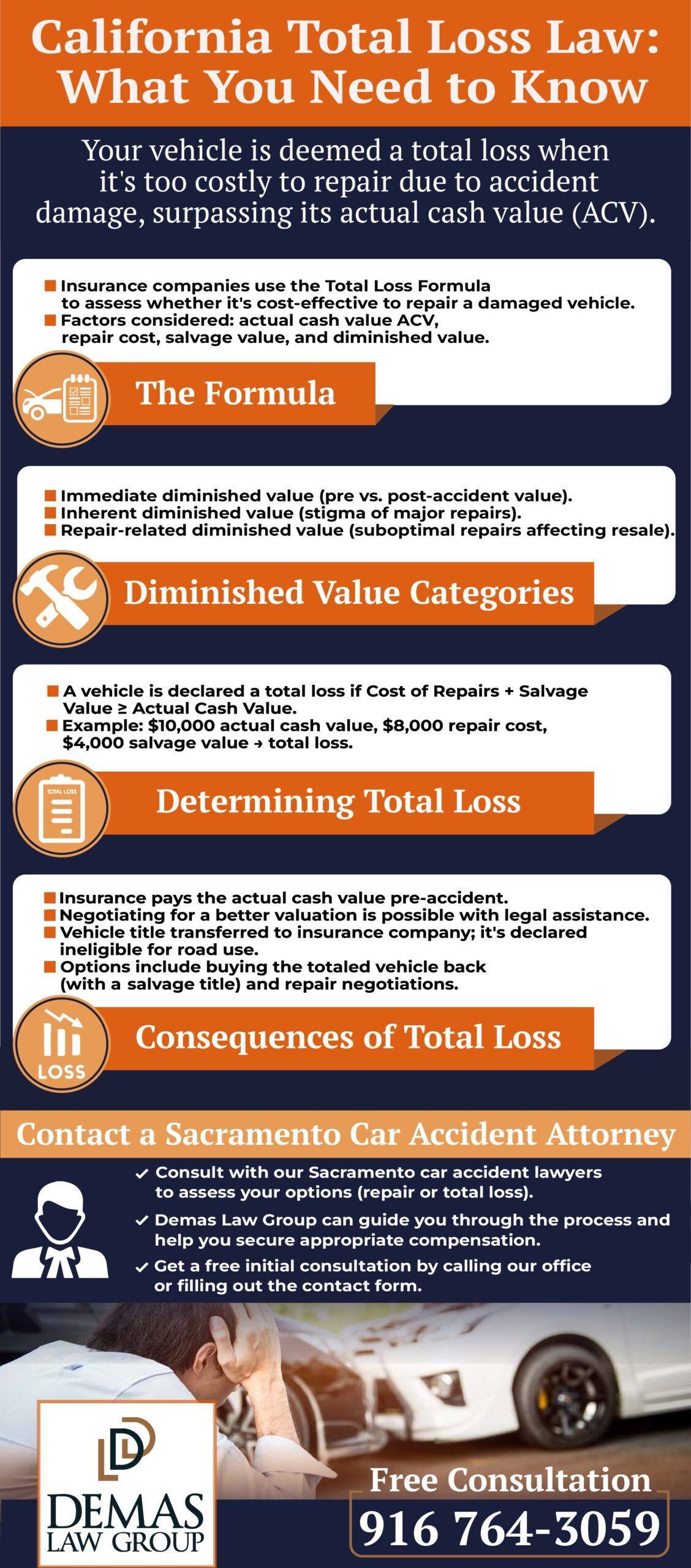A car accident in California can disrupt your life in many ways, and vehicle damage is a major financial concern. Often, the initial insurance settlement offer for car repairs might fall short of the actual costs. This situation can leave you wondering if it would be better for your car to be declared a total loss, potentially leading to a payout that could help you replace your vehicle. Conversely, you might be emotionally attached to your car and prefer to repair it, even if it’s significantly damaged. You may also worry that a total loss settlement won’t be enough to buy a comparable replacement vehicle.
California has specific regulations, known as the Total Loss Formula or Total Loss Law, that determine when a car is considered a total loss. Navigating these rules and understanding your options can be challenging. At Car Repair Online, we aim to clarify these complexities and empower you to make informed decisions about your car after an accident. If you’re facing these questions, understanding the California Total Loss Law is crucial.
Understanding the California Total Loss Threshold
When you file a car insurance claim after an accident, the insurance company will assess the damage to determine whether to repair your vehicle or declare it a total loss. This decision hinges on a few key factors:
- Actual Cash Value (ACV) of Your Vehicle: This is the fair market value of your car immediately before the accident. Insurers determine ACV based on factors like your car’s age, mileage, condition, trim level, and features.
- Cost of Repairs: This is the estimated expense to fix your vehicle and restore it to its pre-accident condition. This includes parts and labor.
- Salvage Value: This is the estimated value of your vehicle in its damaged state. It represents what the insurance company could potentially recoup by selling the damaged car to a salvage yard or for parts. The salvage value depends on the extent of the damage; severely damaged cars might only be worth scrap metal, while less damaged vehicles could have valuable salvageable parts.
Beyond these factors, insurance companies also consider the concept of diminished value. Diminished value refers to the loss in your car’s market value directly resulting from the accident, even after repairs. There are different types of diminished value:
- Immediate Diminished Value: The difference between your car’s value immediately before and immediately after the accident.
- Inherent Diminished Value: The reduction in value because your car has a history of major accident repairs. Many buyers are hesitant to purchase vehicles with significant accident histories, even if repaired perfectly.
- Repair-Related Diminished Value: This occurs when repairs are not fully up to pre-accident standards, even if the car is functional. Imperfect repairs can negatively impact resale value.
How the Total Loss Formula Works in California
Insurance companies in California use a straightforward formula to decide if your car is a total loss. The formula is:
Cost of Repairs + Salvage Value ≥ Actual Cash Value
If the sum of the repair costs and the salvage value is greater than or equal to your car’s actual cash value, the insurance company will likely declare it a total loss.
Let’s illustrate this with an example. Suppose your car’s ACV is appraised at $15,000. After an accident, the repair estimate comes to $9,000, and the salvage value is assessed at $7,000. In this case:
$9,000 (Repair Cost) + $7,000 (Salvage Value) = $16,000$
Since $16,000 is greater than the ACV of $15,000, the insurance company would likely deem your car a total loss.
 Understanding California's Total Loss Formula: Repair Cost, Salvage Value, and Actual Cash Value (ACV) determine total loss. If Repair Cost + Salvage Value is greater than or equal to ACV, the vehicle is typically considered a total loss.
Understanding California's Total Loss Formula: Repair Cost, Salvage Value, and Actual Cash Value (ACV) determine total loss. If Repair Cost + Salvage Value is greater than or equal to ACV, the vehicle is typically considered a total loss.
What Happens When Your Car is Totaled?
If your insurer declares your car a total loss, they will typically offer you a settlement based on the car’s pre-accident Actual Cash Value. This payout is intended to help you replace your vehicle.
However, it’s important to remember that the insurance company’s initial offer may not always be the best possible settlement. Insurers sometimes overlook factors that can increase your car’s value, such as its excellent condition, recent upgrades, meticulous maintenance history, or unique features. They might present a lower offer hoping you’ll accept it quickly.
You have the right to negotiate with the insurance company for a fairer valuation. Researching comparable vehicles in your area and gathering documentation about your car’s condition and features can strengthen your negotiation position.
Once a settlement is reached and your car is declared a total loss, you’ll need to transfer the title to the insurance company. They will then obtain a Salvage Certificate from the California Department of Motor Vehicles (DMV). This certificate legally designates the vehicle as a total loss, primarily suitable for parts or scrap. A vehicle with a Salvage Certificate cannot be legally retitled for road use in its current condition.
Can You Repair a Totaled Car? The Challenges
If you are determined to repair your car, even after it’s been declared a total loss, you’ll face significant hurdles with your insurance company. Insurers are unlikely to reverse their total loss assessment or provide funds for repairs if they’ve already determined the vehicle meets the total loss criteria. Their decision is based on the financial calculation that repairing the car is not economically viable compared to paying out its ACV.
However, in some cases, you might be able to buy back your totaled vehicle from the insurance company for its salvage value. This would mean you receive a reduced settlement (ACV minus salvage value), and you retain possession of your damaged car with a salvage title.
Repairing a car with a salvage title comes with complexities. To legally drive it again, you’ll typically need to:
- Repair the vehicle: You are responsible for all repair costs.
- Salvage Inspection: The repaired vehicle must pass a stringent inspection by the DMV to ensure it meets safety standards.
- Apply for a Revived Salvage Title: If the car passes inspection, you can apply for a new title, often branded as “revived salvage” or similar, indicating its history.
Keep in mind that a vehicle with a salvage history will always have a lower market value than a comparable car with a clean title due to the inherent diminished value. Insurance for revived salvage vehicles can also be more expensive and harder to obtain.
Making the Right Decision: Repair or Total Loss?
Deciding whether to pursue repairs on a damaged car or accept a total loss settlement is a significant decision with financial implications. Carefully consider your options, vehicle’s condition, repair costs, and potential long-term value.
If you’re unsure about the best course of action, especially when dealing with insurance claims and total loss assessments, seeking expert advice is recommended. Consulting with a qualified legal professional or a car repair expert can provide valuable insights and help you navigate this complex process. Car Repair Online is dedicated to providing you with the information and resources you need to make informed choices about your vehicle after an accident.

